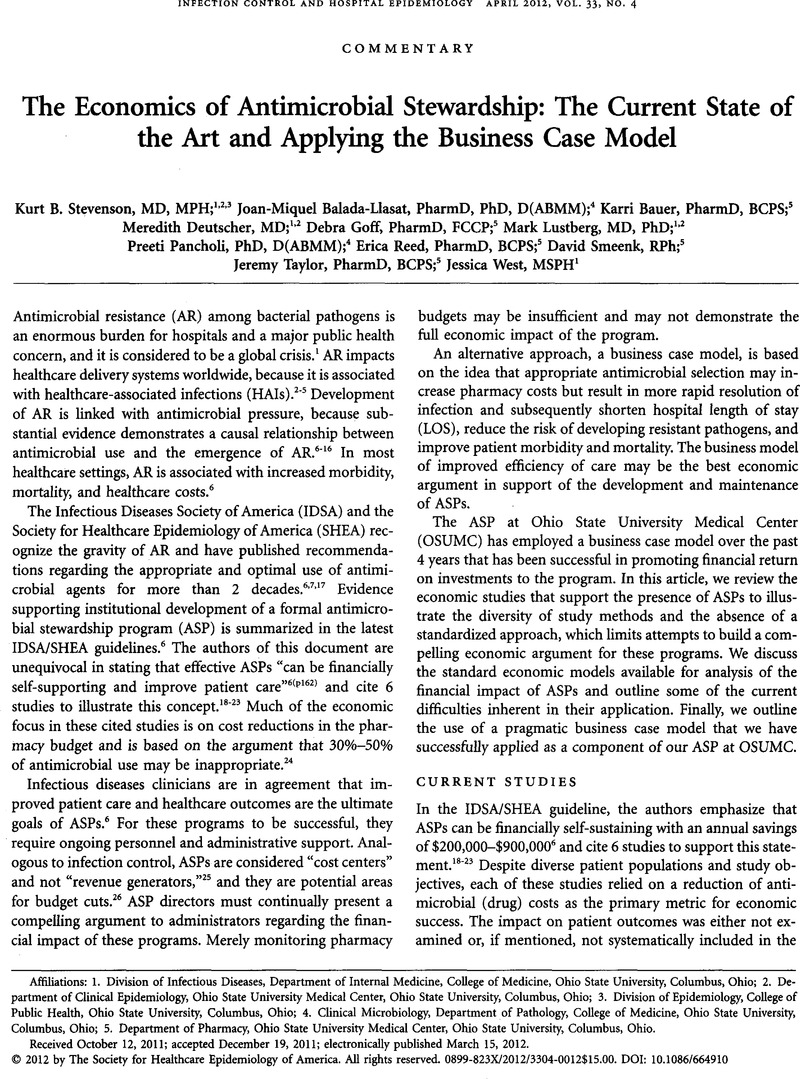Crossref Citations
This article has been cited by the following publications. This list is generated based on data provided by Crossref.
Srinivasan, Arjun
and
Fishman, Neil
2012.
Antimicrobial Stewardship 2012: Science Driving Practice.
Infection Control & Hospital Epidemiology,
Vol. 33,
Issue. 4,
p.
319.
Goff, D. A.
Bauer, K. A.
Reed, E. E.
Stevenson, K. B.
Taylor, J. J.
and
West, J. E.
2012.
Is the "Low-Hanging Fruit" Worth Picking for Antimicrobial Stewardship Programs?.
Clinical Infectious Diseases,
Vol. 55,
Issue. 4,
p.
587.
Newland, Jason G.
Banerjee, Ritu
Gerber, Jeffrey S.
Hersh, Adam L.
Steinke, Leah
and
Weissman, Scott J.
2012.
Antimicrobial Stewardship in Pediatric Care: Strategies and Future Directions.
Pharmacotherapy: The Journal of Human Pharmacology and Drug Therapy,
Vol. 32,
Issue. 8,
p.
735.
Moehring, Rebekah W.
and
Anderson, Deverick J.
2012.
Antimicrobial Stewardship as Part of the Infection Prevention Effort.
Current Infectious Disease Reports,
Vol. 14,
Issue. 6,
p.
592.
Lin, Yu-Shiuan
Lin, I-Fen
Yen, Yung-Feng
Lin, Pei-Ching
Shiu, Yu-chih
Hu, Hsing-Yi
and
Yang, Ying-Pi
2013.
Impact of an antimicrobial stewardship program with multidisciplinary cooperation in a community public teaching hospital in Taiwan.
American Journal of Infection Control,
Vol. 41,
Issue. 11,
p.
1069.
Reed, Erica E.
Stevenson, Kurt B.
West, Jessica E.
Bauer, Karri A.
and
Goff, Debra A.
2013.
Impact of formulary restriction with prior authorization by an antimicrobial stewardship program.
Virulence,
Vol. 4,
Issue. 2,
p.
158.
Mehta, Jimish M.
Haynes, Kevin
Wileyto, E. Paul
Gerber, Jeffrey S.
Timko, Daniel R.
Morgan, Steven C.
Binkley, Shawn
Fishman, Neil O.
Lautenbach, Ebbing
and
Zaoutis, Theoklis
2014.
Comparison of Prior Authorization and Prospective Audit with Feedback for Antimicrobial Stewardship.
Infection Control & Hospital Epidemiology,
Vol. 35,
Issue. 9,
p.
1092.
Bebell, Lisa M.
and
Muiru, Anthony N.
2014.
Antibiotic Use and Emerging Resistance: How Can Resource-Limited
Countries Turn the Tide?.
Global Heart,
Vol. 9,
Issue. 3,
p.
347.
Chamberlain, Ronald S.
Shayota, Brian J.
Nyberg, Carl
and
Sridharan, Prasanna
2014.
The Utility of Procalcitonin as a Biomarker to Limit the Duration of Antibiotic Therapy in Adult Sepsis Patients.
Surgical Science,
Vol. 05,
Issue. 08,
p.
342.
Dodds Ashley, Elizabeth S.
Kaye, Keith S.
DePestel, Daryl D.
and
Hermsen, Elizabeth D.
2014.
Antimicrobial Stewardship: Philosophy Versus Practice.
Clinical Infectious Diseases,
Vol. 59,
Issue. suppl_3,
p.
S112.
Self, Wesley H.
Wunderink, Richard G.
Williams, Derek J.
Barrett, Tyler W.
Baughman, Adrienne H.
Grijalva, Carlos G.
and
O'Neil, Brian J.
2015.
Comparison of Clinical Prediction Models for Resistant Bacteria in Community‐onset Pneumonia.
Academic Emergency Medicine,
Vol. 22,
Issue. 6,
p.
730.
Dhar, Sorabh
Cook, Evelyn
Oden, Mary
and
Kaye, Keith S.
2016.
Building a Successful Infection Prevention Program.
Infectious Disease Clinics of North America,
Vol. 30,
Issue. 3,
p.
567.
Kim, Bongyoung
Kim, Jieun
Kim, Shin-woo
and
Pai, Hyunjoo
2016.
A Survey of Antimicrobial Stewardship Programs in Korea, 2015.
Journal of Korean Medical Science,
Vol. 31,
Issue. 10,
p.
1553.
Principi, Nicola
and
Esposito, Susanna
2016.
Antimicrobial stewardship in paediatrics.
BMC Infectious Diseases,
Vol. 16,
Issue. 1,
Simon, Matthew S.
and
Calfee, David P.
2017.
Infectious Diseases.
p.
1197.
Parker, Sarah K
Hurst, Amanda L
Thurm, Cary
Millard, Matthew
Jenkins, Timothy C
Child, Jason
and
Dugan, Casey
2017.
Anti-infective Acquisition Costs for a Stewardship Program: Getting to the Bottom Line.
Clinical Infectious Diseases,
Vol. 65,
Issue. 10,
p.
1632.
McConnell, Karen J.
Guzman, Oscar E.
Pherwani, Nisha
Spencer, Dustin D.
Van Cura, Jennifer D.
and
Shea, Katherine M.
2017.
Operational and Clinical Strategies to Address Drug Cost Containment in the Acute Care Setting.
Pharmacotherapy: The Journal of Human Pharmacology and Drug Therapy,
Vol. 37,
Issue. 1,
p.
25.
Quiles, Milene Gonçalves
Boettger, Bruno Cruz
Inoue, Fernanda Matsiko
Monteiro, Jussimara
Santos, Daniel Wagner
Ponzio, Vinicius
Carlesse, Fabianne
Cappellano, Paola
Carvalhaes, Cecilia Godoy
and
Pignatari, Antonio Carlos Campos
2019.
Direct matrix-assisted laser desorption ionization time-of-flight mass spectrometry and real-time PCR in a combined protocol for diagnosis of bloodstream infections: a turnaround time approach.
The Brazilian Journal of Infectious Diseases,
Vol. 23,
Issue. 3,
p.
164.
Feyes, Emily E.
Diaz-Campos, Dubraska
Mollenkopf, Dixie F.
Horne, Rikki L.
Soltys, Rachel C.
Ballash, Greg A.
Shelby, Jessica A.
Reed, Erica E.
Stevenson, Kurt B.
Daniels, Joshua B.
Stull, Jason W.
and
Wittum, Thomas E.
2021.
Implementation of an antimicrobial stewardship program in a veterinary medical teaching institution.
Journal of the American Veterinary Medical Association,
Vol. 258,
Issue. 2,
p.
170.
Limato, Ralalicia
Broom, Alex
Nelwan, Erni J.
and
Hamers, Raph L.
2022.
A qualitative study of barriers to antimicrobial stewardship in Indonesian hospitals: governance, competing interests, cost, and structural vulnerability.
Antimicrobial Resistance & Infection Control,
Vol. 11,
Issue. 1,



